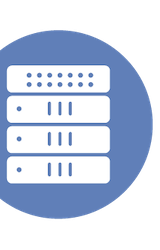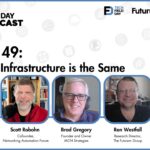Milou Meier attended Security Field Day and provided a look at each of the presenting companies in this LinkedIn Pulse article. Dell Technologies offers a comprehensive range of security services to enhance organizational security. These services include a zero trust framework and managed services. Additionally, AI tools, such as Microsoft Security’s copilot agents, play a crucial role in mitigating cyberattack risks, improving visibility, and optimizing Sec Ops efficiency. Veeam Solutions and Coveware Services provide essential backup and incident response solutions, ensuring resilience against ransomware and other threats.
Make an AI-Ready Data Center With Help From Juniper
Alastair Cooke explores the crucial role of Juniper Networks in preparing data centers for AI workloads, emphasizing optimized network architecture that supports the demanding requirements of AI technologies. He discusses Juniper’s solutions that streamline operations and enhance the efficiency necessary for handling intensive AI-driven processes. For additional insights on AI Infrastructure Field Day 2, see Alastair Cooke’s coverage on The Futurum Group.
Exploring Cloud Resilience, AI, and Data at Cloud Field Day 23
Cloud Field Day is making its highly anticipated return to San Francisco on June 4th and 5th, bringing together some of the biggest names in cloud technology for two days of in-depth insights and live demos. You can catch every moment of the action live on the Tech Field Day LinkedIn page and Techstrong TV. […]
Build Your Own AI Infrastructure Using Google Cloud
Alastair Cooke explores the practicalities and advantages of constructing your own AI infrastructure using Google Cloud, highlighting the accessibility and customization benefits that come with building a bespoke environment. He provides insights into how organizations can leverage Google Cloud’s robust tools and services to tailor AI solutions to their specific needs, enhancing both efficiency and scalability. For additional insights and extensive coverage of AI Infrastructure Field Day 2, watch The Futurum Group blogs.
Wi-Fi is Fast Enough
Modern Wi-Fi connections rely on more than just raw throughput to measure performance. The complexity of wireless as a medium makes the user experience more varied and creates difficulties in troubleshooting. In this episode, Tom Hollingsworth is joined by Keith Parsons, Rocky Gregory, and Ron Westfall as they discuss the state of Wi-Fi and how performance works. They talk about the challenges with properly designed wireless networks and how data sheets make assumptions about the environment. They also discuss user expectations for performance and how workflows involve many moving parts that can impact overall user experiences.
NFD37: Selector Elevates AIOps to the Next Level
In his latest piece for The Futurum Group, Ron Westfall examines how Selector is transforming AIOps by elevating its capabilities during Networking Field Day 37. Westfall explores Selector’s innovative approaches and technologies that are setting new standards in the AIOps arena. For more insights into Networking Field Day 37, check out additional coverage by Ron Westfall on The Futurum Group.
Not All AI Infrastructure Is The Same
Enterprises require vastly different infrastructure for AI. When building your next network, you need to understand what is required in order to achieve specific outcomes. In this episode of the Tech Field Day podcast, Tom Hollingsworth is joined by Scott Robohn, Brad Gregory, and Ron Westfall to discuss the various different types of AI infrastructure. They talk about inferencing and models as well as how to effectively utilize what you currently have. They also discuss what to look for when buying new equipment and how best to put it to use in order to maximize return on investment.
Companies’ AI Readiness Is Lagging Behind Their Optimism: Futurum Research
Dion Hinchcliffe of Futurum Research highlights a significant gap between the optimism of companies regarding AI integration and their actual readiness to implement these technologies. The analysis suggests that while many enterprises are enthusiastic about the potential benefits of AI, they often lack the necessary infrastructure and strategic planning to effectively adopt AI solutions. Sulagna Saha provides further coverage of AI Field Day 6 on Techstrong AI, offering insights into the evolving landscape of artificial intelligence in business.
Redefining Enterprise AI Strategies at AI Field Day 6
At AI Field Day 6, industry leaders and innovators gathered to redefine enterprise AI strategies, showcasing cutting-edge developments and practical deployments. The discussions highlighted emerging technologies and provided insights into effectively integrating AI into various business sectors. For more about AI Field Day 6, watch for further articles on Gestalt IT.
Redefining Enterprise AI Strategies at AI Field Day 6
Stephen Foskett gives a preview of AI Field Day 6, highlighting emerging trends and strategies in enterprise AI that are shaping the industry. Presentations will include Broadcom, which is exploring private AI with VMware, MemVerge, Kamiwaza, and MLCommons. Watch the presentations live on the Tech Field Day website and LinkedIn as well as on Techstrong channels!
Redefining Enterprise AI Strategies at AI Field Day 6
Analysts predict 2025 will be the year AI applications dominate enterprise, with innovations like orchestration engines and optimization software driving secure, efficient integrations. AI Field Day, happening live January 29–30, 2025, will host industry leaders like Broadcom, MemVerge, and Kamiwaza will present solutions for private AI, infrastructure optimization, and real-world use cases, alongside groundbreaking research on CEOs’ AI strategies from The Futurum Group and benchmarks from MLCommons. Watch live on LinkedIn, TechStrong TV, and Tech Field Day, or join the conversation online using #AIFD6.
Where Does Agentic AI Get Its Reasoning Smarts
In this article for Techstrong AI, Sulagna Saha explores the development of advanced reasoning capabilities in Agentic AI, focusing on how these systems acquire and refine their intelligent decision-making processes. She investigates the sources and techniques employed in training AI to simulate human-like reasoning, questioning the implications for future technology. This article was inspired by a talk on agentic AI given by Stephen Foskett during AI Data Infrastructure Field Day 1.
SOUTHWORKS: Reducing Slippage and Increase Scope Control
Guy Currier recently provided an insightful analysis on SOUTHWORKS at AppDev Field Day 2, focusing on their efficient strategies to minimize project slippage and enhance scope control. His coverage highlights the innovative approaches deployed by SOUTHWORKS to manage and deliver complex app development projects effectively. For further details on this topic, explore Guy Currier’s additional reports from AppDev Field Day 2 at The Futurum Group.
Meter Ready to Transform Internet Infrastructure
Ron Westfall recently wrote about Meter, an emerging company poised to revolutionize internet infrastructure through its new hardware platform and network protocol. The technology aims to dramatically enhance the security and efficiency of data transit on the internet. His analysis highlights the potential for Meter’s solution to become a new standard in connectivity, optimizing both network performance and reliability. Read more coverage of Networking Field Day 36 on the Futurum Group website!
Itential Ups Network Automation Intentions Service
Ron Westfall’s latest article explores Itential’s strategic move to enhance network automation by integrating advanced intent-based capabilities into their services. This upgrade aims to simplify complex network configurations and accelerate digital transformation initiatives for their customers. Westfall highlights the potential benefits this upgrade brings to IT teams by improving efficiency and reducing potential errors in network management tasks. Read more in this Futurum Group research note inspired by the Itential presentation at Networking Field Day 36!
Platform9 Delivers On-Premises Private Cloud as a Service
Alastair Cooke discusses Platform9’s innovative approach to simplifying cloud infrastructure by offering an on-premises private cloud as a service. This model combines the convenience of cloud computing with the security and control of on-premise solutions, catering especially to organizations wanting to leverage cloud capabilities while retaining their data onsite. Platform9’s service underscores a significant shift in how companies can now approach their IT infrastructure, emphasizing flexibility and efficiency without the complexities traditionally associated with private cloud deployments. Read more coverage of Cloud Field Day 21 on The Futurum Group website.
There are Too Many Clouds
Public Cloud computing is a large part of enterprise IT alongside on-premises computing. Many organizations that had a cloud-first approach and are now gaining value from on-premises private clouds and seeing their changing business needs leading to changing cloud use. This episode of the Tech Field Day podcast delves into the complexity of multiple cloud providers and features Maciej Lelusz, Jack Poller, Justin Warren, and host Alastair Cooke, all attendees at Cloud Field Day. The awareness of changing business needs is causing some re-thinking of how businesses use cloud platforms, possibly moving away from using cloud vendor specific services to bare VMs. VMs are far simpler to move from one cloud to another, or between public cloud and private cloud platforms. Over time, the market will speak and if there are too many cloud providers, we will see mergers, acquisitions or failures of smaller specialized cloud providers. In the meantime, choosing where to put which application for the best outcome can be a challenge for businesses.
AI Data Infrastructure Field Days – What We Can Take Away
In this research note, Camberley Bates shares insights from the AI Data Infrastructure Field Day event, highlighting significant takeaways that can transform our approach to managing AI data infrastructure. The discussion focused on innovative solutions and strategies that are shaping the future of AI deployments, stressing the importance of adapting to rapidly evolving technological landscapes. These events serve as a crucial platform for IT professionals to gain knowledge on optimizing infrastructure to effectively support AI functions and applications. This note was written for The Futurum Group following AI Data Infrastructure Field Day 1.
Refocusing on Hybrid-Cloud at Cloud Field Day 21
Cloud Field Day will be live on October 23rd and 24th, focusing on the evolving approach to cloud, recognizing that not all applications belong on a public cloud and embracing hybrid and multi-cloud solutions. The event will emphasize the shift in understanding cloud as an operating model rather than just a location, with cloud-native technologies integrating into both public clouds and on-premises data centers. Companies like Platform9, Qumulo, HYCU, and VMware by Broadcom will showcase solutions for cloud management, cross-cloud storage, data protection, and private cloud adoption, while discussions will address key challenges in hybrid and multi-cloud environments. Attendees can watch live and engage with experts as they explore the future of cloud technologies.
Nokia Unleashes EDA to Automate AI Era Data Centers
Nokia is leading the charge in next-generation data center solutions with the launch of its Extreme Data Automation (EDA) platform, which is designed to meet the demands of the AI era. The EDA platform streamlines operations through advanced automation tools, enhancing efficiency and reducing the operational complexities and costs associated with large-scale data center management. This innovation underscores Nokia’s commitment to supporting the infrastructure needs of data-intensive industries, facilitating improved performance and sustainability in enterprise IT environments. Read more in this research note from Ron Westfall of The Futurum Group following our Networking Field Day Exclusive event with Nokia.











